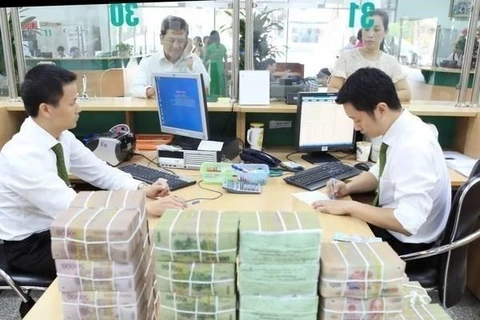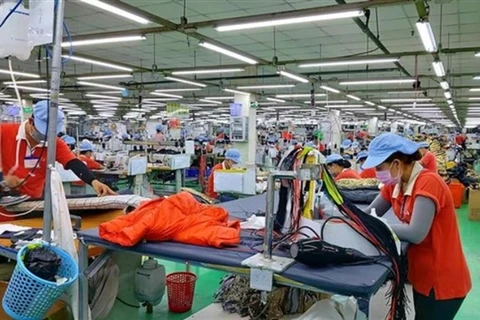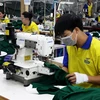Hanoi (VNS/VNA) - After successfully conquering international markets, many businesses have returned to conquer the domestic market as more and more customers choose to buy Vietnamese products.
Lessons learned from the textile industry
Truong Van Cam, Vice President of the Vietnam Textile and Apparel Association (Vitas), said that the textile and garment industry is one of Vietnam's key export industries and creates many jobs for workers. The textile and garment industry’s export turnover reached more than 44 billion USD in 2022. Vietnam's textile and garment industry currently not only promotes exports but also serves the domestic market.
“Many Made-in-Vietnam products, ranging from garments, footwear and seafood to many other industrial products, are exported all over the world, including many developed countries. This is also the pride of Vietnamese products. But we often receive questions about why textiles and garments often focus on exports and forget about the domestic market," said Cam.
“The textile and garment industry does not forget the domestic market. The current production capacity of the Vietnamese textile and garment industry is about 50 billion USD, of which about 85 – 87% is for export while the rest serves the domestic market,” affirmed Cam.
Cam said that the domestic market’s capacity is too small compared to the country’s garment and textile production capacity. Therefore, the textile and garment industry both focuses on exploiting potential export markets and serving the domestic market.
According to the Vitas vice president, Vietnam's textile and garment industry must walk on two feet, not only focusing on the international but also on the domestic market because the domestic market also has great attraction with an expected average per capita income of 4,700 USD in 2024. It is estimated that if about 15% of people's income is spent on consumption, the capacity of the domestic market will reach about 7 billion USD next year.
Challenges in the context of integration
Permanent Vice President of the Vietnam Consumer Goods Development Association Nguyen Thi Thu Thuy said that the domestic consumer market was one of the important fields, always fluctuating, extremely diverse and the driving force of Vietnam’s economy.
“Consumer trends often reflect changes in consumer needs, preferences, habits and values. Grasping and responding to consumer trends is a key factor for consumer goods businesses to compete and develop at any time and in any country,” said Thuy.
However, Thuy said that with the current globalisation trend, especially the boom of e-commerce, competitive pressure on goods is becoming more and more fierce. Meanwhile, consumers themselves, anywhere, can buy goods just by surfing the Internet and ordering from international e-commerce sites is becoming more and more popular and common.
Regarding the textile and garment industry, Cam assessed that at this moment, Vietnamese goods have many advantages in the domestic market, however, "the domestic market is not only full of opportunities and local textile and garment enterprises also face many challenges in the domestic market". Vietnamese garments also have to compete with fake, counterfeit and smuggled goods. When these goods enter Vietnam, their labels are changed to deceive consumers.
According to the Deputy Director of the Domestic Market Department under the Ministry of Industry and Trade, Le Viet Nga, many imported products tend to shift strongly to consumption in the domestic market after new-generation free trade agreements such as CPTPP (Comprehensive and Progressive Agreement for Trans-Pacific Partnership), EVFTA (EU-Vietnam Free Trade Agreement) officially took effect. This is also a huge challenge for domestically produced goods in the context of general integration.
In addition, many foreign retail chains have actively invested in expanding their physical store and warehouse systems in Vietnam to distribute imported goods both online and directly, especially cosmetics and fashion goods, supplementary foods and high-end foods, furniture and household appliances, and products for mothers and babies.
The Ministry of Industry and Trade representative said that the proportion of imported goods in the distribution system, especially cross-border e-commerce channels, will likely increase soon. The scale of Vietnam's retail market has exceeded 180 billion USD in 2023 and is forecast to continue to grow in the following years. At the same time, Vietnamese people's consumption trends have changed a lot.
Nga added that Vietnam has become a fertile land for retailers, but this is also an opportunity for Vietnamese businesses to build brands and expand domestic distribution channels for Vietnamese exported goods, find a solid foothold for Vietnamese products with quality and national brands and key products of localities. Vietnamese businesses also have a more methodical approach to the domestic market, to gradually dominate and keep the "home ground"./.
Lessons learned from the textile industry
Truong Van Cam, Vice President of the Vietnam Textile and Apparel Association (Vitas), said that the textile and garment industry is one of Vietnam's key export industries and creates many jobs for workers. The textile and garment industry’s export turnover reached more than 44 billion USD in 2022. Vietnam's textile and garment industry currently not only promotes exports but also serves the domestic market.
“Many Made-in-Vietnam products, ranging from garments, footwear and seafood to many other industrial products, are exported all over the world, including many developed countries. This is also the pride of Vietnamese products. But we often receive questions about why textiles and garments often focus on exports and forget about the domestic market," said Cam.
“The textile and garment industry does not forget the domestic market. The current production capacity of the Vietnamese textile and garment industry is about 50 billion USD, of which about 85 – 87% is for export while the rest serves the domestic market,” affirmed Cam.
Cam said that the domestic market’s capacity is too small compared to the country’s garment and textile production capacity. Therefore, the textile and garment industry both focuses on exploiting potential export markets and serving the domestic market.
According to the Vitas vice president, Vietnam's textile and garment industry must walk on two feet, not only focusing on the international but also on the domestic market because the domestic market also has great attraction with an expected average per capita income of 4,700 USD in 2024. It is estimated that if about 15% of people's income is spent on consumption, the capacity of the domestic market will reach about 7 billion USD next year.
Challenges in the context of integration
Permanent Vice President of the Vietnam Consumer Goods Development Association Nguyen Thi Thu Thuy said that the domestic consumer market was one of the important fields, always fluctuating, extremely diverse and the driving force of Vietnam’s economy.
“Consumer trends often reflect changes in consumer needs, preferences, habits and values. Grasping and responding to consumer trends is a key factor for consumer goods businesses to compete and develop at any time and in any country,” said Thuy.
However, Thuy said that with the current globalisation trend, especially the boom of e-commerce, competitive pressure on goods is becoming more and more fierce. Meanwhile, consumers themselves, anywhere, can buy goods just by surfing the Internet and ordering from international e-commerce sites is becoming more and more popular and common.
Regarding the textile and garment industry, Cam assessed that at this moment, Vietnamese goods have many advantages in the domestic market, however, "the domestic market is not only full of opportunities and local textile and garment enterprises also face many challenges in the domestic market". Vietnamese garments also have to compete with fake, counterfeit and smuggled goods. When these goods enter Vietnam, their labels are changed to deceive consumers.
According to the Deputy Director of the Domestic Market Department under the Ministry of Industry and Trade, Le Viet Nga, many imported products tend to shift strongly to consumption in the domestic market after new-generation free trade agreements such as CPTPP (Comprehensive and Progressive Agreement for Trans-Pacific Partnership), EVFTA (EU-Vietnam Free Trade Agreement) officially took effect. This is also a huge challenge for domestically produced goods in the context of general integration.
In addition, many foreign retail chains have actively invested in expanding their physical store and warehouse systems in Vietnam to distribute imported goods both online and directly, especially cosmetics and fashion goods, supplementary foods and high-end foods, furniture and household appliances, and products for mothers and babies.
The Ministry of Industry and Trade representative said that the proportion of imported goods in the distribution system, especially cross-border e-commerce channels, will likely increase soon. The scale of Vietnam's retail market has exceeded 180 billion USD in 2023 and is forecast to continue to grow in the following years. At the same time, Vietnamese people's consumption trends have changed a lot.
Nga added that Vietnam has become a fertile land for retailers, but this is also an opportunity for Vietnamese businesses to build brands and expand domestic distribution channels for Vietnamese exported goods, find a solid foothold for Vietnamese products with quality and national brands and key products of localities. Vietnamese businesses also have a more methodical approach to the domestic market, to gradually dominate and keep the "home ground"./.
VNA
























